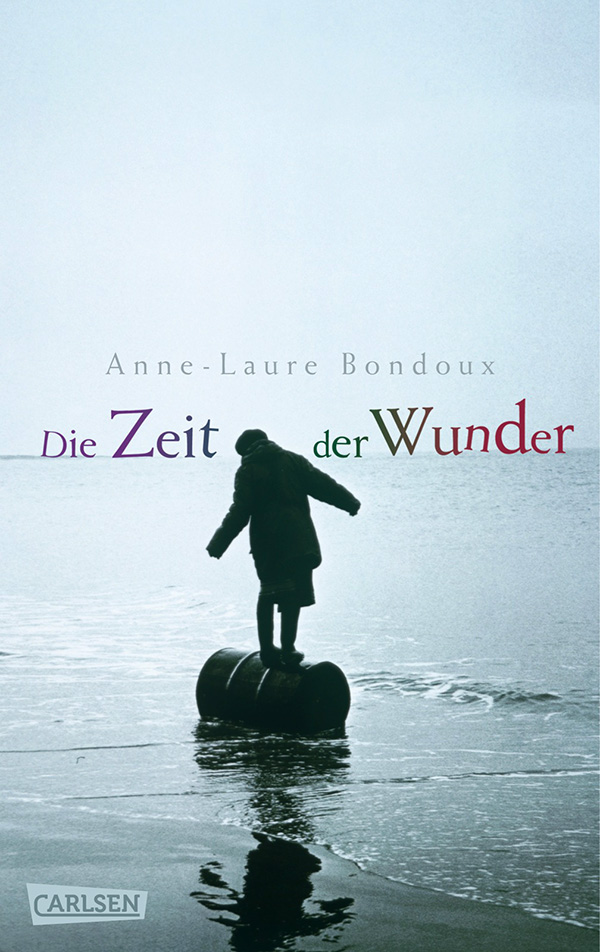During the week of October 21 to 27, 2013 the Academy of the Jewish Museum Berlin, in cooperation with Kulturkind e.V., will host readings, workshops, and an open day for the public with the theme “Multifaceted: a book week on diversity in children’s and young adult literature.” Employees of various departments have been vigorously reading, discussing, and preparing a selection of books for the occasion. Some of these books will be introduced here over the course of the next few months.
 The German cover of the young adult book A Time of Miracles shows a girl balancing in shallow water on a barrel. It strikes me as a pretty, melancholy cover. However, it doesn’t fit the book. (The beach plays no role in the story and the protagonist is a boy.) I hand the book to my 12-year-old daughter and she thinks it looks like a book for adults. My question – whether this is a good or a bad thing – is answered with a shrug.
The German cover of the young adult book A Time of Miracles shows a girl balancing in shallow water on a barrel. It strikes me as a pretty, melancholy cover. However, it doesn’t fit the book. (The beach plays no role in the story and the protagonist is a boy.) I hand the book to my 12-year-old daughter and she thinks it looks like a book for adults. My question – whether this is a good or a bad thing – is answered with a shrug.
Never judge a book by its cover.
Crack it open and read:
“My name is Blaise Fortune and I am a citizen of the French Republic. It’s the pure and simple truth.
I was almost twelve years old the day the customs officers found me in the back of the truck. I stank as badly as the garbage shed where Abdelmalik slept. […] Even though Mr. Ha had faked the official seal [on the picture in my passport] with the greatest care, the customs officers didn’t believe that I was really a French boy. I wanted to explain my story to them, but I didn’t have the vocabulary. So they pulled me out of the truck by the neck of my sweater and took me away.”
What happened before the narrator arrived in France is revealed to the reader a few pages later. I ask my daughter if she understands the book she has just begun to read. “Of course!” she says, inquiring a few minutes later, “What does militia mean?”
The circumstances of a 12-year-old girl in Berlin and our protagonist, who has been on the run for as long as he can remember, could not be more different.
Blaise Fortune’s story consists of other peopleʼs storytelling about who he is and where he is from. Fairytale-like, they are about a railway accident survived by a French baby called Blaise, but not by his mother.
Recounting the stages of an escape over the Caucasus Mountains, he reports of contaminated lakes, of children collecting the wires from old light bulbs.
His story is about love and friendship, but also about brutal violence, war, and fear.
The French author Anne-Laure Bondoux tells the story in such a way that it touches the reader, because she puts forward the accidental nature of our identity. What if I had been born in war-torn Chechnya? If I had to keep in mind that I might need a new place to stay the next day? If I had to hide from soldiers who could kill me? (Militia, those are soldiers!)
Though the twists of the plot surprised me less than my daughter, I had to wipe away tears here and there. I found the ending hopeful, optimistic, and very moving.
My daughter is outraged: That is supposed to be a good ending? Never! (She likes the book anyway.) For young readers a happy ending needs to be a really happy ending, otherwise it doesn’t count at all.
For jaded adult readers on the other hand, it’s almost kitschy if the hero of the story arrives at home in France after fleeing for so many years, finds personal happiness, and reconciles himself at last to his past. (Nearly as kitschy as the book cover.)
Christine Marth, Publications
Anne-Laure Bondoux, A Time of Miracles, translated from the French by Y. Maudet, USA: Ember 2012, 192 pages, age range 12 and up.
